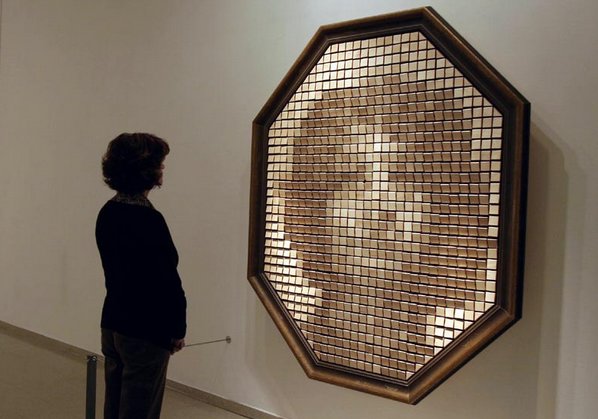Daniel Rozin is a New York based artist working in the area of interactive digital art, and the Associate Art Professor at ITP, Tisch School Of The Arts, NYU. Art Report recently spoke with him about his artwork and current exhibition at Manhattan’s bitforms gallery.
Q: Tell us a little about your background…Did you originally pursue art or was it technology that peaked your interest?
My background is in industrial design. I worked as an industrial designer for 10 years before going back to school to NYU’s Interactive Telecommunications Program (ITP) where I learned how to author software and do some basic electronics.
Once I had those skills I discovered an urge to use them for my own self expression and not for design projects for clients. Some people are lucky that their talent resides in painting or sculpting.
“For me, my creativity lies in the intersection of technology, art, and sculpture.”
Q: When did you decide to make the transition into art?
My first mirror installation was Easel from 1997 (I was 36). My first Mechanical Mirror was Wooden Mirror from 1999.
With Easel, I was not aware I was creating a mirror. I was just allowing viewers to paint their likeness and wasn’t really aware I was making art. However, after receiving the Ars Electronica Award I was energized to create more art and more mirrors.
In 1999 I got the courage and support of NYU ITP (where I currently teach) to create the first mechanical piece, which awarded me the prestigious Chrysler Design Award. This put me on track to create many iterations of mechanical mirrors (30 in total).

Q: Many of your works are “mirrors”…what about mirrored images interest you?
I find the mirror, as an interface and paradigm, very successful and useful for the creation of participatory interactive art. All technologically-based art requires an interface and reflection is a very simple and satisfying one.
“Mirrors are also very interesting objects that allow us to experience our being from the vantage point of others, which is very different from the way we experience ourselves internally.”
Q: Do you hope to influence the way people view their own reflections?
Yes, looking at your reflection is a unique experience and a rather intimate one. Most of my pieces are placed in a public setting so you are a bit exposed when you lend your likeness to the piece. For that reason, I make my pieces reflect an abstract image of you rather than a detailed one which would have people thinking about their blemishes, wrinkles and such. I want my mirrors to reflect and capture your soul, not your superficial details…
Q: Do you view your work as a collaboration between yourself and the viewer?
Yes, I want the audience to take ownership of the piece and feel a partnership in the creation of the art-moment which is their likeness in my piece. Beyond that I want them to feel joyful and appreciate the aesthetics and the craft that goes into the creation of these pieces.

Q: How do you decide what materials to use? (Why Penguins? Why Pom-Poms?)
I am drawn to materials, especially materials of nature. I am interested in the intrinsic quality of physical materials and the contrast between those and the ephemeral quality of the digital and computational.
Penguins are black and white, making them an inevitable pixel candidate. They huddle in groups. They are birds that don’t fly but they swim very gracefully. In the Penguins Mirror, I programmed some transformation animations that resemble flocking of birds and schooling of fish. Perhaps these penguins are dreaming of flying.

I have wanted to use fabrics and soft materials for some time but couldn’t come up with a way to bridge the gap between the idiosyncratic behavior of soft materials and the complexity of mechanical systems. The breakthrough was when I realized that a soft fur ball (faux!) had a unique ability to squeeze and then recover its volume. This way the Pom-Poms can force their way through the neighboring Pom-Poms.

Q: Your work combines human interaction and technology in very unique way. What about this intersection inspires you?
We are surrounded by technology and in many ways our lives are governed by these interactions. I try to create interactions that are close to human nature and intuition rather than close to the technology and its needs. These tools are very powerful and enable the creation of very unique art pieces.
Q: Are there other practical applications of this technology?
Yes there are. In the process of developing my art, I find myself developing techniques and technologies that are suitable for other applications. I have registered three patents for such developments, however in the past 10 years I have decided not to pursue intellectual property protection for my inventions. I primarily perceive them as art and I am more interested in that.

Q: What do you hope to achieve with your work? What dialogue would you like to start?
The main issues that my art deals with are audience participation, image creation and perception and physicality. These are issues that I think are accessible to most audience, so I am lucky that I don’t have some complicated story to tell.
I want my art to talk to as many people as possible, I want it to be joyful, and beautiful, and gratifying on many levels. I find that once people interact with a piece and get the superficial parts of it they start thinking about deeper motivations and nuances in the piece and that is where the fun starts.
Want to know what you would look like in Pom-Pom form? Visit Manhattan’s bitforms gallery where Rozin’s exhibition, Descent With Modification, is open to the public until July 1st.







